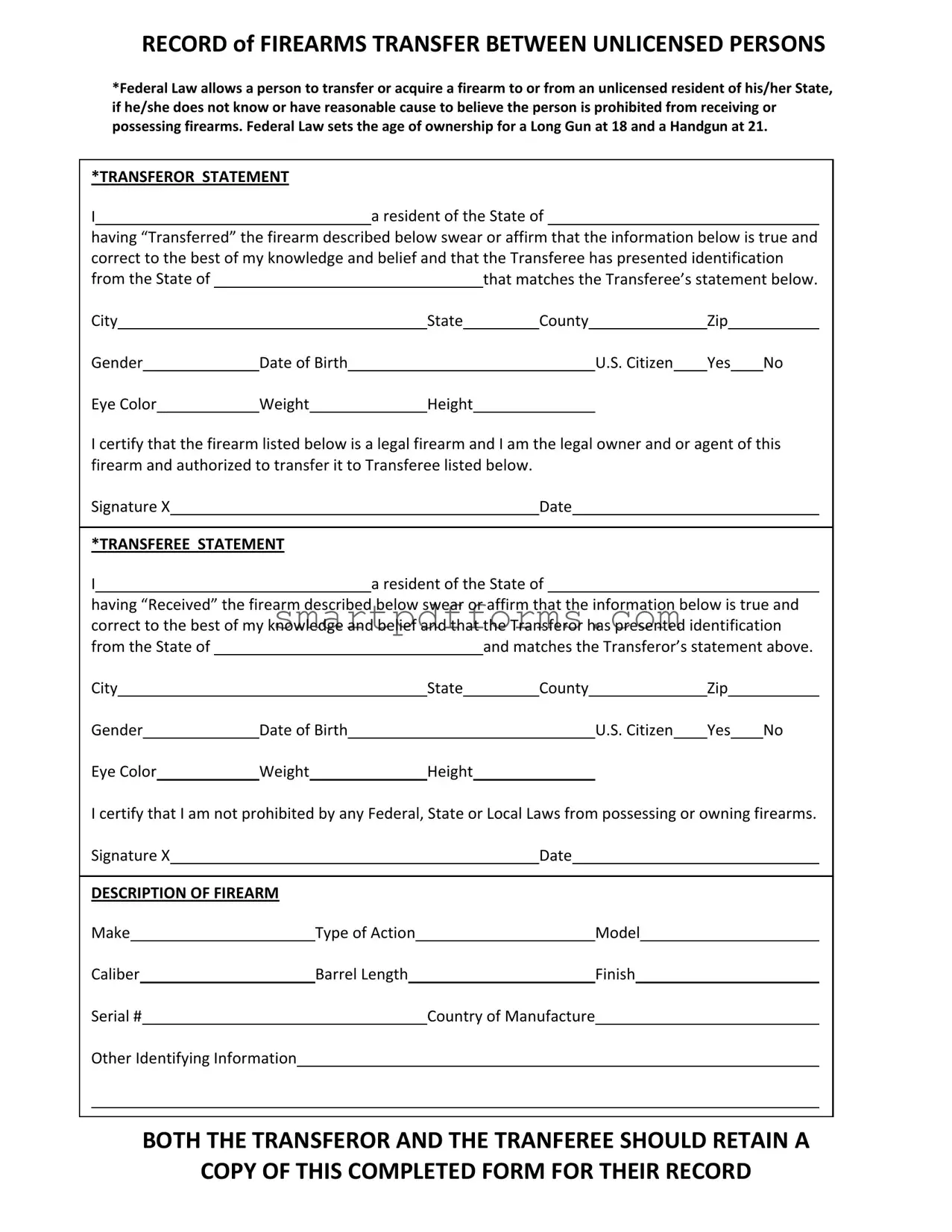
RECORD of FIREARMS TRANSFER BETWEEN UNLICENSED PERSONS
*Federal Law allows a person to transfer or acquire a firearm to or from an unlicensed resident of his/her State, if he/she does not know or have reasonable cause to believe the person is prohibited from receiving or possessing firearms. Federal Law sets the age of ownership for a Long Gun at 18 and a Handgun at 21.
*TRANSFEROR STATEMENT |
|
I |
a resident of the State of |
having “Transferred” the firearm described below swear or affirm that the information below is true and correct to the best of my knowledge and belief and that the Transferee has presented identification
|
|
|
|
|
|
|
|
|
|
|
|
|
|
|
|
|
|
|
|
|
|
|
|
|
|
from the State of |
|
|
|
|
|
|
|
|
that matches the Transferee’s statement below. |
|
|
City |
|
|
|
|
|
|
State |
|
|
County |
|
Zip |
|
|
|
|
|
Gender |
|
|
Date of Birth |
|
|
|
|
|
|
|
|
U.S. Citizen |
|
Yes |
|
No |
|
|
Eye Color |
|
|
Weight |
|
|
Height |
|
|
|
|
|
|
|
|
|
|
|
|
|
I certify that the firearm listed below is a legal firearm and I am the legal owner and or agent of this |
|
|
firearm and authorized to transfer it to Transferee listed below. |
|
|
|
|
|
|
Signature X |
|
|
|
|
|
|
|
|
|
|
Date |
|
|
|
|
|
|
|
|
|
|
|
|
|
|
|
|
|
|
|
|
|
|
|
|
|
*TRANSFEREE STATEMENT |
|
|
|
|
|
|
|
|
|
|
|
|
|
|
|
|
I |
|
|
|
|
a resident of the State of |
|
|
|
|
|
having “Received” the firearm described below swear or affirm that the information below is true and correct to the best of my knowledge and belief and that the Transferor has presented identification
|
|
|
|
|
|
|
|
|
|
|
|
|
|
|
|
|
|
|
|
from the State of |
|
|
|
|
|
|
|
and matches the Transferor’s statement above. |
City |
|
|
|
|
|
State |
|
|
County |
|
Zip |
|
|
|
Gender |
|
|
Date of Birth |
|
|
|
|
|
|
|
U.S. Citizen |
|
Yes |
|
No |
Eye Color |
|
|
Weight |
|
Height |
|
|
|
|
|
|
|
|
|
|
I certify that I am not prohibited by any Federal, State or Local Laws from possessing or owning firearms.
|
Signature X |
|
|
|
|
|
Date |
|
|
|
|
|
|
|
|
|
|
|
|
|
|
|
|
|
|
|
|
DESCRIPTION OF FIREARM |
|
|
|
|
|
|
|
|
|
|
|
Make |
|
Type of Action |
|
|
|
Model |
|
|
|
|
|
|
|
|
|
|
|
|
|
|
|
|
|
|
Caliber |
|
Barrel Length |
|
|
|
|
Finish |
|
|
|
Serial # |
|
|
|
|
Country of Manufacture |
|
|
|
|
|
|
|
|
|
|
|
|
|
|
|
|
Other Identifying Information |
|
|
|
|
|
|
|
|
|
|
|
|
|
|
|
|
|
|
|
|
|
|
|
|
|
|
|
|
|
|
|
|
|
|
|
|
|
|
|
|
|
|
|
|
|
|
BOTH THE TRANSFEROR AND THE TRANFEREE SHOULD RETAIN A
COPY OF THIS COMPLETED FORM FOR THEIR RECORD
To whom may an unlicensed person transfer firearms under the GCA?
A person may sell a firearm to an unlicensed resident of his State, if he does not know or have reasonable cause to believe the person is prohibited from receiving or possessing firearms under Federal law. A person may loan or rent a firearm to a resident of any State for temporary use for lawful sporting purposes, if he does not know or have reasonable cause to believe the person is prohibited from receiving or possessing firearms under Federal law. A person may sell or transfer a firearm to a licensee in any State. However, a firearm other than a curio or relic may not be transferred interstate to a licensed collector.
[18 U.S.C. 922(a)(3) and (5), 922(d), 27 CFR 478.29 and 478.30]
From whom may an unlicensed person acquire a firearm under the GCA?
A person may only acquire a firearm within the person’s own State, except that he or she may purchase or otherwise acquire a rifle or shotgun, in person, at a licensee's premises in any State, provided the sale complies with State laws applicable in the State of sale and the State where the purchaser resides. A person may borrow or rent a firearm in any State for temporary use for lawful sporting purposes.
[18 U.S.C. 922(a)(3) and (5), 922(b)(3), 27 CFR 478.29 and 478.30]
May an unlicensed person obtain a firearm from an out-of-State source if the person arranges to obtain the firearm through a licensed dealer in the purchaser’s own State?
A person not licensed under the GCA and not prohibited from acquiring firearms may purchase a firearm from an out-of-State source and obtain the firearm if an arrangement is made with a licensed dealer in the purchaser's State of residence for the purchaser to obtain the firearm from the dealer.
[18 U.S.C. 922(a)(3) and 922(b)(3)]
What record-keeping procedures should be followed when two private individuals want to engage in a firearms transaction?
When a transaction takes place between private (unlicensed) persons who reside in the same State, the Gun Control Act (GCA) does not require any record keeping. A private person may sell a firearm to another private individual in his or her State of residence and, similarly, a private individual may buy a firearm from another private person who resides in the same State. It is not necessary under Federal law for a Federal firearms licensee (FFL) to assist in the sale or transfer when the buyer and seller are "same-State" residents. Of course, the transferor/seller may not knowingly transfer a firearm to someone who falls within any of the categories of prohibited persons contained in the GCA. See 18 U.S. C. §§ 922(g) and (n). However, as stated above, there are no GCA-required records to be completed by either party to the transfer.
There may be State or local laws or regulations that govern this type of transaction. Contact State Police units or the office of your State Attorney General for information on any such requirements.
Please note that if a private person wants to obtain a firearm from a private person who resides in another State, the firearm will have to be shipped to an FFL in the buyer's State. The FFL will be responsible for record keeping.
http://www.atf.gov/firearms/faq/faqindex.htm

